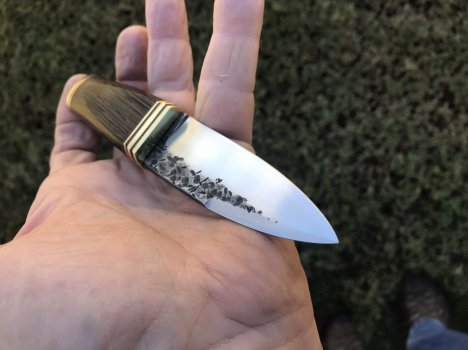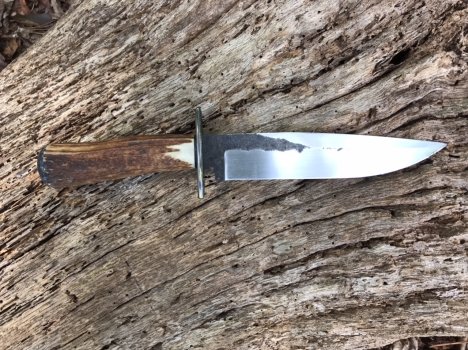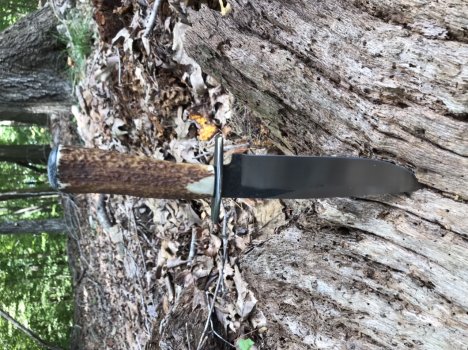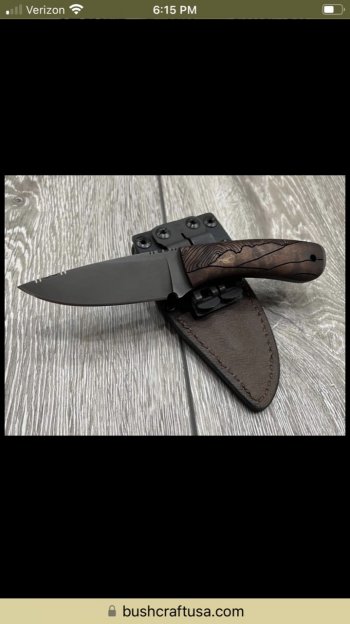My honyaki blade was kinda thick at the top of the blade road, so in some ingredients, it would wedge. Most Honyaki blades I have seen are pretty thick (probably less chance of cracking during the quench), especially towards the spine, so the performance was only so so. It was a buffed mirror finish and had deeper scratches underneath the buffed finish. I didn't really notice much special edge holding wise compared to other steels at similar rockwells (or Super Steels) and sharpening it was fine, too. I have a 52100 blade and it is much thinner and performs much better! $900 for a Honyaki blade with a buffed finished and a faint temper line isn't worth it IMHO! My other $200-$250 Japanese gyuto performed better.
I ran into a few people who made comments like " Oh, you don't forge your blades?" or "Isn't forging better?". I would tell them stock removal allows me to use a much wider variety of steels, including stainless and tool steels, as well as forging steels. Fif brought forging knives to the forefront, but people have little clue that you can do a knife entirely from stock removal and it's still a very good knife! Some people think a knife HAS to be forged by a bladesmith! Forging allows you to use other sizes of materials and not have to grind as much away, but limits your steel choices. I know stock removal knives can pass the ABS tests, but you have to forge your blades to be a Master Smith. I wish there was a similar certification for stock removal blades as well as forged blades!
In the Japanese kitchen knife community, some people really frown on stamped out blades from mill rolled san mai steel and push forged blades as superior. I've had some of both and the mill san mai performs just as well as the forged stuff or better! The forged stuff has more character to the lamination line typically over the plain straighter line, but the smith can also reforge the billet to get the more active lamination line, too.
I use damascus bar stock and grind away, but I want to start forging my own damascus and san mai barstock to use as well. I ran into inclusions with Alabama Damascus and the steels aren't my choice either. I used a piece of Damascus from Randy Haas and it was a joy to work and came out beautiful!! I don't mind the forged finish when done intentionally and done well, but when it's haphazard and not done well (pits all over where the blade is ground), it looks horrible. Same with seeing wonky grind lines, multi faceted bevels or the edge bevel that is super thick/wide. Some people think it's a great knife because it's forged, and accept poor fit and finish because it is supposed to be "rustic" looking. Forged knives can look just as clean or bad as stock removal knives! It's in the skill of the maker. FiF seems to have really lowered people's expectations on fit and finish though in most cases and doesn't always showcase what the makers are really capable of!
I ran into a few people who made comments like " Oh, you don't forge your blades?" or "Isn't forging better?". I would tell them stock removal allows me to use a much wider variety of steels, including stainless and tool steels, as well as forging steels. Fif brought forging knives to the forefront, but people have little clue that you can do a knife entirely from stock removal and it's still a very good knife! Some people think a knife HAS to be forged by a bladesmith! Forging allows you to use other sizes of materials and not have to grind as much away, but limits your steel choices. I know stock removal knives can pass the ABS tests, but you have to forge your blades to be a Master Smith. I wish there was a similar certification for stock removal blades as well as forged blades!
In the Japanese kitchen knife community, some people really frown on stamped out blades from mill rolled san mai steel and push forged blades as superior. I've had some of both and the mill san mai performs just as well as the forged stuff or better! The forged stuff has more character to the lamination line typically over the plain straighter line, but the smith can also reforge the billet to get the more active lamination line, too.
I use damascus bar stock and grind away, but I want to start forging my own damascus and san mai barstock to use as well. I ran into inclusions with Alabama Damascus and the steels aren't my choice either. I used a piece of Damascus from Randy Haas and it was a joy to work and came out beautiful!! I don't mind the forged finish when done intentionally and done well, but when it's haphazard and not done well (pits all over where the blade is ground), it looks horrible. Same with seeing wonky grind lines, multi faceted bevels or the edge bevel that is super thick/wide. Some people think it's a great knife because it's forged, and accept poor fit and finish because it is supposed to be "rustic" looking. Forged knives can look just as clean or bad as stock removal knives! It's in the skill of the maker. FiF seems to have really lowered people's expectations on fit and finish though in most cases and doesn't always showcase what the makers are really capable of!





